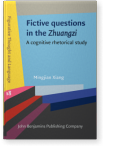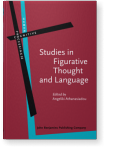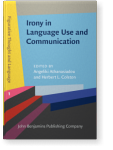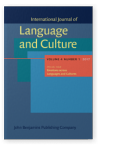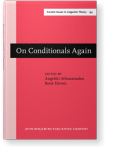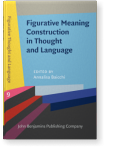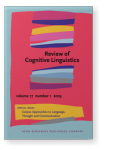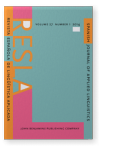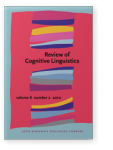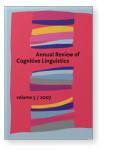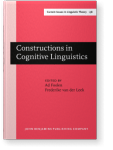Angeliki Athanasiadou
List of John Benjamins publications for which Angeliki Athanasiadou plays a role.
Online Resource
E-ISSN 1877-9638
Book series
Studies in Figurative Thought and Language
Edited by Angeliki Athanasiadou
[Human Cognitive Processing, 56] 2017. x, 327 pp.
Subjects Cognition and language | Pragmatics | Theoretical linguistics
Irony in Language Use and Communication
Edited by Angeliki Athanasiadou and Herbert L. Colston
[Figurative Thought and Language, 1] 2017. x, 282 pp.
Subjects Cognition and language | Cognitive linguistics | Communication Studies | Humor studies | Philosophy | Pragmatics | Psycholinguistics
Emotions across Languages and Cultures
Edited by Angeliki Athanasiadou and Ad Foolen
Special issue of International Journal of Language and Culture 4:1 (2017) v, 119 pp.
Subjects Anthropological Linguistics | Applied linguistics | Cognition and language | Cognitive psychology | Communication Studies | Pragmatics
On Conditionals Again
Edited by Angeliki Athanasiadou and René Dirven †
[Current Issues in Linguistic Theory, 143] 1997. viii, 418 pp.
Subjects Semantics | Syntax | Theoretical linguistics
2024 Metaphor clusters in political discourse Review of Cognitive Linguistics: Online-First Articles | Article
The paper explores the creative combination of metaphors, both complex and mixed. The data for the study are drawn from political discourse concerning the target concept of crisis. Building on the argument that constructional parameters facilitate metaphor clustering, the paper also focuses on… read more
2020 Intensification via figurative language Figurative Meaning Construction in Thought and Language, Baicchi, Annalisa (ed.), pp. 91–106 | Chapter
Figurative language, generally speaking, involves intended meaning; it is employed in order to communicate something beyond the very meaning of the elements of a construction. This is largely accomplished by the incongruence of domains, scripts, frames or entities that participate in the… read more
2019 APO X, Y: A discourse topicalization construction within Greek Twitter Corpus Approaches to Language, Thought and Communication, Lu, Wei-lun, Naděžda Kudrnáčová and Laura A. Janda (eds.), pp. 187–218 | Article
The paper accounts for the Greek discourse topicalization construction APO X, Y and the sarcastic and humorous effects that arise in the context of Twitter exchanges. Our analysis is based on the analytical tools of the Lexical Constructional Model (henceforth LCM) as formulated in Ruiz de… read more
2017 Chapter 6. If-clauses and their figurative basis Studies in Figurative Thought and Language, Athanasiadou, Angeliki (ed.), pp. 151–175 | Chapter
The objective of the chapter is to demonstrate that the cognitive processes of metaphor and metonymy may determine the form of grammatical constructions and may be responsible for the elaboration of their meaning. The positions that constitute the framework in the chapter are: (a)… read more
2017 Pride: Metaphors and metonymies for the expression of a “deadly sin” Emotions across Languages and Cultures, Athanasiadou, Angeliki and Ad Foolen (eds.), pp. 6–23 | Article
The aim of the paper is to discuss the linguistic and conceptual devices employed for the expression of the emotion of pride in English and Greek culture. The focus will be (a) on the way the emotion of pride is conceptualized in the two cultures, (b) on the way it is expressed, not only in… read more
2017 Introduction. Figurative thought, figurative language, figurative grammar? Studies in Figurative Thought and Language, Athanasiadou, Angeliki (ed.), pp. 1–14 | Chapter
2017 Chapter 9. Irony has a metonymic basis Irony in Language Use and Communication, Athanasiadou, Angeliki and Herbert L. Colston (eds.), pp. 201–216 | Chapter
Irony often cooperates with many other figures like metonymy, metaphor, hyperbole, simile. Metonymy, is argued, constitutes the basis for irony. To this effect, two frequent types of constructions that exhibit irony are studied. The particular constructions that encourage and activate irony are the… read more
2017 Introduction: The irony of irony Irony in Language Use and Communication, Athanasiadou, Angeliki and Herbert L. Colston (eds.), pp. 1–16 | Introduction
2014 Metaphors and metonymies for the (conceptualization and expression of the) state of no emotion in English and Greek Revista Española de Lingüística Aplicada/Spanish Journal of Applied Linguistics 27:1, pp. 1–22 | Article
The vocabulary of emotion terms has been treated both within and across cultures. Emotion terms, especially terms of universal emotion concepts, have been largely discussed. What has received little or no attention at all is the state of no emotion. The paper explores this state in English and… read more
2007 Before and after: Relations of anteriority and posteriority along ‘paths’ of conceptual structure Annual Review of Cognitive Linguistics: Volume 5, Ruiz de Mendoza Ibáñez, Francisco José (ed.), pp. 1–26 | Article
The paper deals with the way events are ordered in a sequence with respect to each other and with respect to the speaker. When ordered with respect to each other, one event serves as the temporal reference point for establishing mental contact with another event, the target. Taking the speaker as… read more
2000 Pragmatic Conditionals Constructions in Cognitive Linguistics: Selected papers from the Fifth International Cognitive Linguistics Conference, Amsterdam, 1997, Foolen, Ad and Frederike van der Leek (eds.), pp. 1–26 | Article
1997 Introduction On Conditionals Again, Athanasiadou, Angeliki and René Dirven † (eds.), pp. 1–14 | Miscellaneous
1997 Conditionality, hypotheticality, counterfactuality On Conditionals Again, Athanasiadou, Angeliki and René Dirven † (eds.), pp. 61–96 | Article
1994 The pragmatics of answers Pragmatics 4:4, pp. 561–574 | Article
1993 Presenting A User's Grammar of English ITL - International Journal of Applied Linguistics 99/100, pp. 57–85 | Article
1991 The discourse function of questions Pragmatics 1:1, pp. 107–122 | Article
